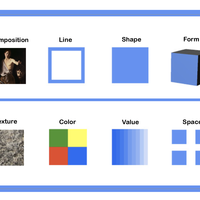More about Violin
- All
- Info
- Shop

Contributor
One could say that Picasso was obsessed with music.
Don’t believe me? Pablo Picasso is known for a few things: Edward Scissorhands-looking people, his colorful periods (no, not *that* kind), guitars, and violins. Between 1912 and 1914, almost half of Picasso’s paintings feature instruments. He was even BFFs with the composer Igor Stravinsky (the two were once arrested together for “drunken behavior”). Those two geniuses bonded over the fact that they both had arch nemeses: Stravinsky’s was Shoenberg, Picasso’s was Matisse - who also liked music).
Some people say that the guitar was Picasso’s favorite instrument - they may even go as far as to say that guitars are the most significant instruments in modern art. While this may be true, let’s not forget about the violin - likely Picasso’s number 2 choice - and a hugely popular subject for him as well. So, you may feel like you’ve seen this violin before, or at least a similar one.
What is special about this particular Violin is that it is an example of “analytical cubism.” This basically means that it’s science-y cubism. In this style, Picasso breaks up the object (a violin), and takes the pieces and depicts them from different angles - think of Tony Stark’s hologram computer that can spin around and show the same object from all kinds of perspectives. The painting is dense at the center, and the outside of the oval is more sparse, inviting the eye to return back to the different angles and points of view at the center of the frame. Pretty brilliant stuff there.
This lack of distinctiveness is an inherent quality of music. People sometimes talk about how music is abstract and thus open to the listener’s interpretation. Cubism similarly verges on this kind of deconstruction or abstraction, giving viewers more space to create their own narrative from what they are seeing. In this piece, the only signs of the violin are the scroll and f holes (once again, not *that* kind - get your mind out of the gutter!).
Soon after its creation, this painting landed in the hands of Wilhelm Uhde - a German collector, dealer, and critic. However, at the start of World War I, French authorities took possession of the artwork. In 1921, it was sold at the Hôtel Drouot - one of the world’s oldest auction houses. Making this painting even more well-traveled, it now lives happily in the collection of the Kröller-Müller Museum in The Netherlands.
Sources
- “File:Pablo Picasso, 1911-12, Violon (Violin), oil on canvas, Kröller-Müller Museum, Otterlo, Netherlands.jpg.” Wikipedia, accessed 27 June 2019, https://en.wikipedia.org/wiki/File:Pablo_Picasso,_1911-12,_Violon_(Viol…%
- Gopnik, Blake. “Pablo Picasso: Guitar Hero.” Newsweek, 20 February 2011, accessed 27 June 2019, https://www.newsweek.com/pablo-picasso-guitar-hero-68535.
- Ladonne, Jennifer. “Hôtel Drouot: The World’s Oldest Auction House.” France Today, 11 April 2015, accessed 27 June 2019, https://www.francetoday.com/culture/art_and_design/hotel_drouot_the_wor….
- Michalska, Magda. “Picasso’s Favorite Instrument…” Daily Art Magazine, 26 September 2016, accessed 27 June 2019, https://www.dailyartmagazine.com/picassos-favourite-instrument/.
- Miller, Simon. “Instruments of Desire: Musical Morphology in the Early Work of Picasso.” From The Musical Quarterly, Vol. 76, No. 4 (Winter, 1992), pp. 443-464. Accessed via Jstor on 27 June 2019, from https://www.jstor.org/stable/742471.
- “Pablo Picasso: Musical Instruments.” Nevada Museum of Art, accessed 27 June 2019, https://www.nevadaart.org/art/exhibitions/pablo-picasso-musical-instrum….
- “Picasso Violin.” Google search (to prove the frequency), 27 June 2019, https://www.google.com/search?biw=1280&bih=610&ei=IXAVXf7REZKe_Qaeg6nwD…
- Service, Tom. “What Picasso and Stravinsky do have in common.” The Guardian, 20 March 2009, accessed 27 June 2019, https://www.theguardian.com/music/tomserviceblog/2009/mar/19/stravinsky….
- “Stravinsky and Picasso: how two cultural giants became collaborators.” Classic fm, accessed 27 June 2019, https://www.classicfm.com/lifestyle/wellbeing/stravinsky-picasso/.
- “Violon (Violin).” Kroller-Muller Museum, accessed 27 June 2019, https://krollermuller.nl/en/pablo-picasso-violin-1.
- “Wilhelm Uhde.” Wikipedia, accessed 27 June 2019, https://en.wikipedia.org/wiki/Wilhelm_Uhde.
- Wolfman, Ursula Rehn. “Picasso and Music.” Interlude, 25 February 2011, accessed 27 June 2019, https://www.interlude.hk/front/picasso-and-music/.














